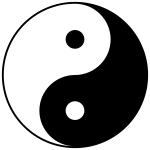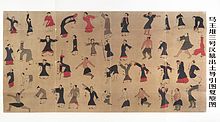도인
| 도교 |
|---|
 |
도인(導引)은 도교의 수행법 중의 하나이다. 도인은 신체를 굴신(屈伸)하거나 마찰하거나 하여 혈액의 순환을 좋게 하는 안마 · 체조라고도 불리는 건강법으로서 조식(調息)과 병용하는데, 탁한 기(氣)를 체외로 배출하고 원기(元氣)를 체내에 저장하는 수행법을 뜻한다.[1]
도인(導引)은 지금의 안마법(按摩法)과 비슷하여 마사지나 지압(指壓)도 이에 원류를 둔 것이지만 양생술(養生術:不老體 육성의 肉體純化法)에서 말하는 도인법은 그 범위가 매우 넓다.[2] 여기에는 몸의 각 부분을 도인하는 방법 외에도 병을 퇴치하는 각병좌공법(却病座功法)이 있으며, 이완법(弛緩法)으로 심신의 긴장을 풀면 자율신경실조증(自律神經失調症)을 비롯하여 고혈압 · 암 · 심장병 · 천식 · 갑상선 종양 등 긴장으로 인하여 생기는 모든 병이 퇴치됨은 물론 균정제법(均整齊法)도 아울러 수행하면 만병이 퇴치되는 것이라 한다.[2]
각주[편집]
참고 문헌[편집]

 이 문서에는 다음커뮤니케이션(현 카카오)에서 GFDL 또는 CC-SA 라이선스로 배포한 글로벌 세계대백과사전의 "종교·철학 > 한국의 종교 > 한국의 도교 > 한국도교의 의식·수행 > 도인" 항목을 기초로 작성된 글이 포함되어 있습니다.
이 문서에는 다음커뮤니케이션(현 카카오)에서 GFDL 또는 CC-SA 라이선스로 배포한 글로벌 세계대백과사전의 "종교·철학 > 한국의 종교 > 한국의 도교 > 한국도교의 의식·수행 > 도인" 항목을 기초로 작성된 글이 포함되어 있습니다.
 이 문서에는 다음커뮤니케이션(현 카카오)에서 GFDL 또는 CC-SA 라이선스로 배포한 글로벌 세계대백과사전의 "종교·철학 > 세계의 종교 > 도교 > 도교 > 수행법·의례 > 도인" 항목을 기초로 작성된 글이 포함되어 있습니다.
이 문서에는 다음커뮤니케이션(현 카카오)에서 GFDL 또는 CC-SA 라이선스로 배포한 글로벌 세계대백과사전의 "종교·철학 > 세계의 종교 > 도교 > 도교 > 수행법·의례 > 도인" 항목을 기초로 작성된 글이 포함되어 있습니다.
도인(기공) [ 편집 ]
| 시리즈 엔트리 |
| 중의학 |
|---|
 |


도인은 몸의 움직임 에 초점을 맞추고 호흡 과 협력하는 건강 요법으로 고대 춤 동작 에서 비롯되었습니다 . 춘추 전국시대에 도음법은 상당한 발전을 이루었고 "형경", "요신" 등의 기법이 등장하였다 . 마왕퇴 한 3호분 에서 출토된 "도인도"의 40개 이상의 자세는 진나라 이전 의 도인 기법을 요약한 것이다. 초기 도인에도 기공 과 안마가 포함되었으나 , 수나라와 당나라 이후 기공 과 안마는 점차 도인에서 분리되었다.
도인법 은 독보적인 건강보존법 으로서 과거 왕조에서 발전되어 왔으며 , 주나라 때 교태자가 창시 한 " 기성 자도 음법" , 당나라 , 송나라 의 저명한 광두 승려 가 창안 한 " 광도 도인 기법 " , 청나라 조정동 이 창안 한 " 노인 도인 법 " .
Daoyin은 Zhuangzi에 처음 등장했습니다. "Zhuangzi · Deliberate"는 "불고 숨쉬고 옛 것을 내쉬고 새 것을 받아들이고 곰경과 새가 뻗어있는 것은 장수를위한 것입니다. 이 방법은 사람을 인도하고 사람을 양성하며 Peng Zushou 시험관이 좋아합니다." Chen Yuanying은 다음과 같이 말했습니다. 『수문·서방법』: “중앙은 땅이 평평하고 젖어서 천지가 만물에 가득하다. 그리고 열과 치료는 蹻에 의해 유도되어야 하므로 도인법도 누르는 것과 구부리는 것도 중심에서 나옵니다.” 왕빙의 논평은 다음과 같이 말했습니다: 몸을 구부린다는 것은 손과 발을 재빨리 들어 올리는 것을 의미합니다.”
도인법에는 침 , 이 두드리기, 인두 헹굼, 북 치기, 마른 머리 빗기, 마른 얼굴 씻기, 귀 비비기, 눈 비비기, 발바닥 비비기, 신장 주머니 비비기, 자발적 동원, 전신 두드리기 등이 있습니다 . 그것은 종종 일련의 연습을 형성하기 위해 설득력과 생각과 결합됩니다.
[ 편집 ] 참조
참조 [ 편집 ]
- "고의적으로 장자"
- "쑤웬·다양한 방법과 적절한 논의"
Daoyin
| Daoyin | |||
|---|---|---|---|
| Traditional Chinese | 導引 | ||
| Literal meaning | "guide and pull" | ||
| |||

Daoyin is a series of cognitive body and mind unity exercises practiced as a form of Daoist neigong, meditation and mindfulness to cultivate jing (essence) and direct and refine qi, the internal energy of the body according to Traditional Chinese medicine. These exercises are often divided into yin positions, lying and sitting, and yang positions, standing and moving. [1] The practice of daoyin was a precursor of qigong,[2]and was practised in Chinese Taoist monasteries for health and spiritual cultivation.[2] Daoyin is also said to be[3]a primary formative ingredient in the well-known "soft styles" of the Chinese martial arts, of Taiji quan.[4] and middle road styles like Wuxingheqidao.
The main goal of daoyin is to create flexibility of the mind therefore creating harmony between internal and external environments, which relaxes, replenishes and rejuvenates the body, developing in its practitioners a vital and healthy spirit.[citation needed]
In the West, daoyin is sometimes mistakenly equated with "daoist yoga" or "yin yoga" as "dao" (導) and "yin" (引) are mistakenly read as 'Dao' (道), as in "Daoism", and 'Yin' (阴), as in "Yin-Yang".[citation needed]
The Daoyin Tu[edit]


A painted scroll on display at the Hunan Provincial Museum and known as the Daoyin Tu found in tomb three at Mawangdui in 1973 and dated to 168 BC shows coloured drawings of 44 figures in standing and sitting postures performing daoyin exercises. It is the earliest physical exercise chart in the world so far, and illustrates a medical system which does not rely on external factors such as medication, surgery or treatments, but utilizes solely internal factors to prevent disease.
Translation of the texts covering the document show that the early Chinese were aware of the need for both preventive and corrective breathing exercises. The exercises can be divided into three categories:
- Postures of bodily exercises such as stretching arms and legs, leaning over, hopping, dancing, breathing exercises and using various equipment such as a stick and a ball.
- Imitating animal behaviour such as dragon, monkey, bear and crane.
- Exercises targeted at specific diseases.[5]
Effects[edit]
A typical daoyin exercise will involve movement of the arms and body in time with controlled inhalation and exhalation. Each exercise is designed with a different goal in mind, for example calmative effects or expanded lung capacity.
According to Mantak Chia the practice of daoyin has the following effects: harmonization of the qi, relaxation of the abdominal muscles and the diaphragm, training of the "second brain" in the lower abdomen, improvement of health and structural alignment.[7]
See also[edit]
- Chinese alchemy
- Dantian
- Huangdi Neijing
- Internal alchemy
- Jing
- Lee-style t'ai chi ch'uan
- Qigong
- Silk reeling
- Taoist philosophy
- Wudang Mountains
- Yangsheng (Daoism)
- Yin Yoga
- Yinshu
- Zhang Sanfeng
References[edit]
- ^ Taoist Ways of Healing by Chee Soo chapter 11 Tao Yin - Taoist Respiration Therapy page 113(Aquarian Press/Thorsons - HarperCollins 1986
- ^ a b Huang, Jane (1987). The Primordial Breath, Vol. 1. Original Books, Inc. ISBN 0-944558-00-3.
- ^ Eberhard, Wolfram (1986). A Dictionary of Chinese Symbols: Hidden Symbols in Chinese Life and Thought. Routledge & Kegan Paul, London. ISBN 0-415-00228-1.
- ^ Lao, Cen (April 1997). "The Evolution of T'ai Chi Ch'uan – T'AI CHI The International Magazine of T'ai Chi Ch'uan Vol. 21 No. 2". T'ai Chi. Wayfarer Publications. ISSN 0730-1049.
- ^ "Hunan Provincial Museum". Archived from the original on 2016-07-16. Retrieved 2017-03-12.
- ^ Taoist Ways of Healing by Chee Soo chapter 11 Tao Yin - Taoist Respiration Therapy page 114(Aquarian Press/Thorsons - HarperCollins 1986
- ^ Chia, Mantak (September 2005). Energy Balance through the Tao: Exercises for Cultivating Yin Energy. Destiny Books. ISBN 159477059X.
8. Smith, Ronald and Carmone, Antonio (2022), Shadows of Mawangdui Animating the Daoyintu, Three Pines Press, ISBN 9781931483704
External links[edit]
- Entry on Daoyin from the Center for Daoist Studies
- The origin of Daoyin Inscription from a Warring State Period cultural relic - neigong.net
- Theory of essence Qi and spirit - neigong.net
- Entry on Tao Yin at the Seahorse Mediawiki
- 马王堆汉墓陈列全景数字展厅—湖湖南省博物馆 (Virtual tour of the Mawangdui Han Tombs exhibit at the Hunan Provincial Museum).
